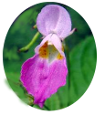
 |
Trek to Valley of FlowersA travelogue which can tell you how to go there on a limited budget |
|
|
| Android App for identifying flowers found in and around Valley of Flowers |
The valley is home to many celebrated flowers like the Brahmakamal, the Blue Poppy and the Cobra Lily. It is a much sought after haunt for flower-lovers, botanists and of course trekkers, for whom a sufficient excuse to embark on a mission to reach a place, is that it exists!
This article is a travelogue aimed to guide newbies about how to reach Valley of Flowers, with a limited budget. It is for those who want to go there as a group of friends, and not part of an organised tour, which is an easier, but not so much fun way to go there.
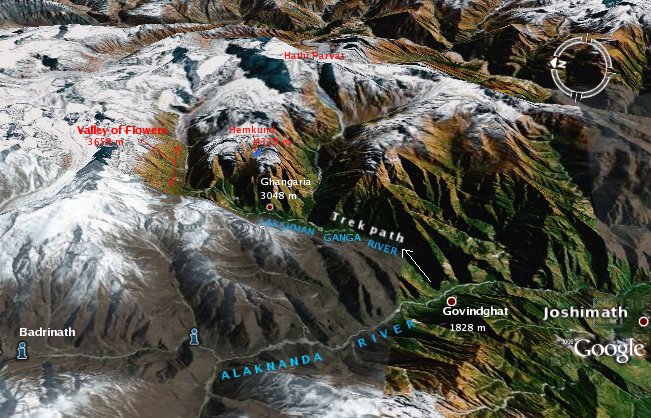
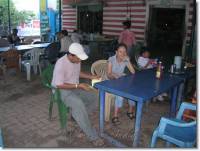 Let us start from Delhi, which most people pass through, even if they are
coming from Pune, Mumbai or Calcutta. Yes, people do come from that far
off, not to speak of foreigners. If you are unorganised like us, you will
not have booked train tickets in advance. So, the only option is to go to
the ISBT, Anand Vihar (not Kashmere Gate), and catch a bus to Rishikesh.
It is better to
start early in the morning, as one can get a deluxe bus. In the afternoon,
only the ordinary buses will be there which will stop every now and then to
pick up passengers. The bus takes about 6 hours, and one will get to stop
in between for snack and tea. The journey is likely to be uneventful, and
not very interesting, as most commuters will be going from Delhi to Roorkee
or Haridwar. We met a saffron-clad sanyasin, who was a follower of Swami
Agnivesh - we had a brief chat on her ideology during a stop-over for tea.
Rishikesh is a small, noisy town with Ganga flowing right through it. One
can easily find hotels for overnight stay - we found a 3-bed room for Rs.
350 per day (but that was in 2006).
Let us start from Delhi, which most people pass through, even if they are
coming from Pune, Mumbai or Calcutta. Yes, people do come from that far
off, not to speak of foreigners. If you are unorganised like us, you will
not have booked train tickets in advance. So, the only option is to go to
the ISBT, Anand Vihar (not Kashmere Gate), and catch a bus to Rishikesh.
It is better to
start early in the morning, as one can get a deluxe bus. In the afternoon,
only the ordinary buses will be there which will stop every now and then to
pick up passengers. The bus takes about 6 hours, and one will get to stop
in between for snack and tea. The journey is likely to be uneventful, and
not very interesting, as most commuters will be going from Delhi to Roorkee
or Haridwar. We met a saffron-clad sanyasin, who was a follower of Swami
Agnivesh - we had a brief chat on her ideology during a stop-over for tea.
Rishikesh is a small, noisy town with Ganga flowing right through it. One
can easily find hotels for overnight stay - we found a 3-bed room for Rs.
350 per day (but that was in 2006).
Leaving the plains behind
You can have a last look at the plains of Rishikesh because you won't get
to see them for at least five days. Next morning we started for Joshimath.
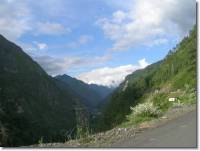 And starting early is very important - start as early as you can - you will
see the advantage as you travel.
There are two ways - either take a Garhwal Mandal bus which takes 11 hours
(ouch! my backside!), or take shared Tata Sumos. The roads on that route
are dangerous (let's be frank), and so buses are not allowed to ply at
night - as a consequence, the last Joshimath bound bus leaves Rishikesh at
9 AM! Of course, there is a
And starting early is very important - start as early as you can - you will
see the advantage as you travel.
There are two ways - either take a Garhwal Mandal bus which takes 11 hours
(ouch! my backside!), or take shared Tata Sumos. The roads on that route
are dangerous (let's be frank), and so buses are not allowed to ply at
night - as a consequence, the last Joshimath bound bus leaves Rishikesh at
9 AM! Of course, there is a
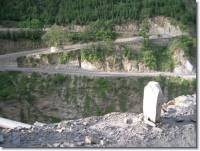 third way, hire a Sumo for yourself, but that option is not for the budget
conscious trekker, who is quite likely to be a student. Sumos are fast and will
take you there in 8-9 hours, but there is no direct shared-Sumos plying
between Rishikesh and Joshimath. You will get a Sumo from Rishikesh to
Rudr-prayag. Be careful that all jeep-like vehicles are called Sumos - 10
persons packed into a Sumo is not very uncomfortable, but in some others,
it can be. From Rudraprayag, you can easily get a shared Sumo to
Karn-prayag, or if lucky, to Chamoli. In Chamoli everybody seems to be
going to Joshimath. So, the route should be:
third way, hire a Sumo for yourself, but that option is not for the budget
conscious trekker, who is quite likely to be a student. Sumos are fast and will
take you there in 8-9 hours, but there is no direct shared-Sumos plying
between Rishikesh and Joshimath. You will get a Sumo from Rishikesh to
Rudr-prayag. Be careful that all jeep-like vehicles are called Sumos - 10
persons packed into a Sumo is not very uncomfortable, but in some others,
it can be. From Rudraprayag, you can easily get a shared Sumo to
Karn-prayag, or if lucky, to Chamoli. In Chamoli everybody seems to be
going to Joshimath. So, the route should be:
Rishikesh - Rudr-prayag - Karn-prayag - Chamoli - Joshimath
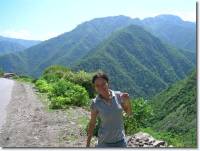 During the 252 km journey from Rishikesh to Joshimath, you will get tired
(mainly of sitting immobile in the Sumo), but you will also be treated to
panoramic views of the mountains. The road winds around the green mountains,
and one cannot help admire their beauty, and at the same time shudder at
downward
slopes which can tumble you down into the river Alaknanda, which we follow
all the way. We felt reassured seeing numerous warning signs like "main
pahaadi naagin hoon - tez chalne waalo ko dasti hoon" (I am the
mountain naagin [female cobra], and will strike at those who drive fast). The Sumo
occasionally stops for a cup of tea, or for lunch. Incidently, the word
prayag stands for confluence - so, whenever you come across a
Karn-prayag or Dev-prayag, you can look for two rivers joining.
One thing to note is that while Rishikesh is at an altitude of 356 m,
Joshimath is at 1890 m - so, the bus really has to climb on the way.
During the 252 km journey from Rishikesh to Joshimath, you will get tired
(mainly of sitting immobile in the Sumo), but you will also be treated to
panoramic views of the mountains. The road winds around the green mountains,
and one cannot help admire their beauty, and at the same time shudder at
downward
slopes which can tumble you down into the river Alaknanda, which we follow
all the way. We felt reassured seeing numerous warning signs like "main
pahaadi naagin hoon - tez chalne waalo ko dasti hoon" (I am the
mountain naagin [female cobra], and will strike at those who drive fast). The Sumo
occasionally stops for a cup of tea, or for lunch. Incidently, the word
prayag stands for confluence - so, whenever you come across a
Karn-prayag or Dev-prayag, you can look for two rivers joining.
One thing to note is that while Rishikesh is at an altitude of 356 m,
Joshimath is at 1890 m - so, the bus really has to climb on the way.
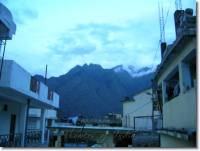 Joshimath is the halt for the night, and gearing up for
the next day. Joshimath has many cheap and comfortable hotels. We got a
double-bed room for Rs. 200. Recharge your camera batteries and tank up
with chips, chocolates or whatever is close to your heart. All this should
be done at night, because the next day starts early, and earlier the
better. Remember that, from Joshimath onwards, the prices of goods increase
as the altitude increases. Regarding communication, once in Joshimath, we
realize the emptiness of mobile service providers' slogans like, "our
network follows you wherever you go..." - only BSNL works there!
Joshimath is the halt for the night, and gearing up for
the next day. Joshimath has many cheap and comfortable hotels. We got a
double-bed room for Rs. 200. Recharge your camera batteries and tank up
with chips, chocolates or whatever is close to your heart. All this should
be done at night, because the next day starts early, and earlier the
better. Remember that, from Joshimath onwards, the prices of goods increase
as the altitude increases. Regarding communication, once in Joshimath, we
realize the emptiness of mobile service providers' slogans like, "our
network follows you wherever you go..." - only BSNL works there!
Joshimath is the place where Adi Shankaracharya set up a 'mutt' in the 8th century. Mutt (मठ) is not just a temple - it is something like a monastry, which follows and propagates a particular school of thought. However, you will not see any ancient temple there, although a Shankaracharya temple is there.
The Grind: the 14 km trek
Now comes the most difficult part, the 14 km trek from Govindghat to
Ghangria. But first we have to reach Govindghat, which is a 21 km drive
from Joshimath. It is raining in the morning - we haven't still got used
to the mountain ways where rain doesn't affect one's routine. We take a
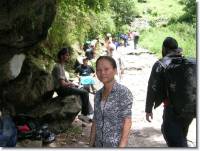 Sumo to drive through the most dangerous road in our lives. The road is
narrow, sometimes just makeshift after a landslide, and we can see
river Alaknanda thundering along down below. Reaching Govindghat, one
has to walk about a km to reach the bustling small town, which serves
mostly as a starting point of the trek to Hemkund Sahib, the beautiful
lake, considered holy by the sikhs. We see sikhs, sikhs, and more sikhs.
In fact, there are so many of them that we start wondering if there is
anybody at all going to the Valley of Flowers. We enter one of the
Sumo to drive through the most dangerous road in our lives. The road is
narrow, sometimes just makeshift after a landslide, and we can see
river Alaknanda thundering along down below. Reaching Govindghat, one
has to walk about a km to reach the bustling small town, which serves
mostly as a starting point of the trek to Hemkund Sahib, the beautiful
lake, considered holy by the sikhs. We see sikhs, sikhs, and more sikhs.
In fact, there are so many of them that we start wondering if there is
anybody at all going to the Valley of Flowers. We enter one of the
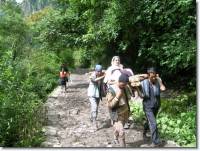 numerous dhaabas there and catch a cup of hot tea. Standing in
the back window of the dhaba, we can see the pilgrims moving slowly
along the steep track on the mountain, wearing shiny colorful raincoats.
That makes us wonder if we should buy a raincoat too. Thought of
investing money in a raincoat, just for this trek, makes us hesitant.
But an enquiry reveals that these are temporary raincoats, just plastic
sheets in the appropriate shape, which one can pull over one's head, and
it cost a rediculous Rs 15. As it turned out later, we haven't ever invested
Rs 15 better! Those raincoats turned out to be the most useful thing we
carried.
numerous dhaabas there and catch a cup of hot tea. Standing in
the back window of the dhaba, we can see the pilgrims moving slowly
along the steep track on the mountain, wearing shiny colorful raincoats.
That makes us wonder if we should buy a raincoat too. Thought of
investing money in a raincoat, just for this trek, makes us hesitant.
But an enquiry reveals that these are temporary raincoats, just plastic
sheets in the appropriate shape, which one can pull over one's head, and
it cost a rediculous Rs 15. As it turned out later, we haven't ever invested
Rs 15 better! Those raincoats turned out to be the most useful thing we
carried.
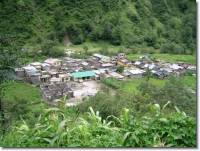 We move out of the town by crossing a foot bridge on the river which
flows through Govindghat, and start climbing the track. There are lots
and lots of mule-waalas who offer to take us up. There are also porters
(called Pitthoo) who offer to carry out luggage on their backs.
In our initial enthusiasm and confidence, we ignore all porters and
climb on with our luggage, not knowing how it was going to turn out,
this being our first experience of the kind. The track is littered with
mule dung and there is strong smell of mule dung which persists till
Ghangria. The track is crowded by sikh pilgrims - they move along
frequently chanting "Sat-naam, waahe guru!", mainly to help themselves go on.
There are mules carrying goods and mules carrying people. One has to be
careful and move to the hill-side (not the down-slope-side) when a mule
comes along, otherwise the danger of being accidentally pushed over the the
slope is very real.
We move out of the town by crossing a foot bridge on the river which
flows through Govindghat, and start climbing the track. There are lots
and lots of mule-waalas who offer to take us up. There are also porters
(called Pitthoo) who offer to carry out luggage on their backs.
In our initial enthusiasm and confidence, we ignore all porters and
climb on with our luggage, not knowing how it was going to turn out,
this being our first experience of the kind. The track is littered with
mule dung and there is strong smell of mule dung which persists till
Ghangria. The track is crowded by sikh pilgrims - they move along
frequently chanting "Sat-naam, waahe guru!", mainly to help themselves go on.
There are mules carrying goods and mules carrying people. One has to be
careful and move to the hill-side (not the down-slope-side) when a mule
comes along, otherwise the danger of being accidentally pushed over the the
slope is very real.
Slowly we realize the mistake of not getting a porter to carry our luggage. The climb is mostly steep, and occasionally levels out. But we put up a brave face and carry on. The path moves along river Lakshman Ganga, which flows down below. As we move up, we come closer to the level at which the river flows. There are tea and snack stalls along the way, which serve tea, "maggie" noodles, aloo-prathas, chips etc. Anything you buy here, is costlier than Govindghat, mainly because everything has to be hauled up on mules. We break our journey frequently, stopping for tea, noodles or parathas.
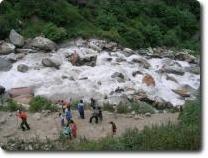 On the way, we pass the Bhyundaar village which looks
picturesque, set in the middle of the mountains and the river flowing
through it. Further up and we are able to climb down and reach the
river. We decide to relax for some time next to the river. The flow is
strong and nobody dares climb down into the cold water. Our eyes are
peeled for flowers, and we already spot species of Cobra Lily, Clematis
vine, and the beautiful Inula, which is sunflower like flower. Our
flower hunt has already begun.
On the way, we pass the Bhyundaar village which looks
picturesque, set in the middle of the mountains and the river flowing
through it. Further up and we are able to climb down and reach the
river. We decide to relax for some time next to the river. The flow is
strong and nobody dares climb down into the cold water. Our eyes are
peeled for flowers, and we already spot species of Cobra Lily, Clematis
vine, and the beautiful Inula, which is sunflower like flower. Our
flower hunt has already begun.
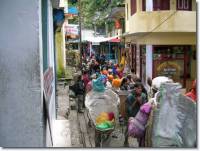 The trek continues and the last bit is a very steep climb which tires out
everybody. The rule of the mountains is that one shouldn't get
disappointed with the tiring climbs - one is always rewarded with a
beautiful view from the top. We feel rejuvinated on spotting a
mile-stone which says, Ghangria 1 km. We spot a helipad on the side and
a few tents, probably belonging to some organised tour company.
The trek continues and the last bit is a very steep climb which tires out
everybody. The rule of the mountains is that one shouldn't get
disappointed with the tiring climbs - one is always rewarded with a
beautiful view from the top. We feel rejuvinated on spotting a
mile-stone which says, Ghangria 1 km. We spot a helipad on the side and
a few tents, probably belonging to some organised tour company.
We rest a bit and then go for the final walk which takes us into
Ghangria, a small village by the side of the river Lakshman Ganga.
Ghangria, it seems, serves only one purpose - act as a base camp for
people going to Hemkund and the Valley of Flowers. There no houses
visible - only hotels. The passage through the village is narrow,
uneven, strewn with mule-dung wetted with rain, lined with hotels on
both sides. It is like a crowded bazaar. The biggest building there is
the Gurudwara. The GMVN guesthouse is fully booked in advance. We
realize the mistake of having started a bit late in the morning, and
taking a bit longer to reach up, because of carrying our luggage on our
own - the hotels are all packed. Seemed to be an unusually crowded day.
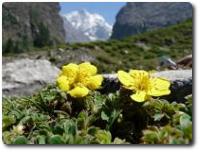 With difficulty, we manage to find a place for the night. They provide
us with blankets, and there are shops where blankets and sleeping bags
can be rented. The Gurudwara is always a fallback option for staying -
it provides free accomodation to anybody who comes, and provide them with
a blanket.
With difficulty, we manage to find a place for the night. They provide
us with blankets, and there are shops where blankets and sleeping bags
can be rented. The Gurudwara is always a fallback option for staying -
it provides free accomodation to anybody who comes, and provide them with
a blanket.
We have dinner at one of the many restaurants there, all of which serve almost identical menu, a typical city punjabi food, and retire for the night. The next morning we get up and look for a better accomodation, which is easily available, because people returning from Hemkund the previous night, are all leaving for Govindghat. We are raring to go into the valley, and start off after getting some parathas and boiled eggs packed.
Entering the Fairy-Land
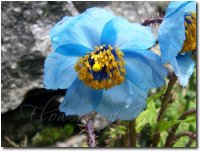 The Valley of Flowers is a 3 km climb from Ghangria. We walk out of
Ghangria, from the side opposite to the one from which we entered the
previous day. We cross a bridge across Lakshman Ganga, which we see
falling down from the rocky mountain far away. It originates from the
Hemkund lake. After the bridge, the path bifurcates - the right one
goes to Hemkund, and the left one leads to the Valley of Flowers. No
mules are allowed into the Valley, although you can ride one right upto
Hemkund. And the difference is noticed soon - the smell of mule-dung
which had gotten to our heads, is replaced by pleasant smell of
vegetation. We cross the checkpost after entering our names in the
register, and paying a nominal fee. There is a stream coming down from
The Valley of Flowers is a 3 km climb from Ghangria. We walk out of
Ghangria, from the side opposite to the one from which we entered the
previous day. We cross a bridge across Lakshman Ganga, which we see
falling down from the rocky mountain far away. It originates from the
Hemkund lake. After the bridge, the path bifurcates - the right one
goes to Hemkund, and the left one leads to the Valley of Flowers. No
mules are allowed into the Valley, although you can ride one right upto
Hemkund. And the difference is noticed soon - the smell of mule-dung
which had gotten to our heads, is replaced by pleasant smell of
vegetation. We cross the checkpost after entering our names in the
register, and paying a nominal fee. There is a stream coming down from
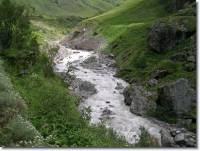 the left, and one has to cross it over a makeshift bridge. The path goes
down, and there is an iron bridge over Pushpawati river which hurtles
down with great fury, and meets Lakshman Ganga at Ghangria. Exotic
flowers start right from here. Blue poppies are here on the rocks beside the
bridge, but most visitors walk past without noticing them.
Interestingly, there are only a few who keenly look for flowers - most
have either yoga and meditation on their mind, or are just trekkers
looking for a beautiful place.
the left, and one has to cross it over a makeshift bridge. The path goes
down, and there is an iron bridge over Pushpawati river which hurtles
down with great fury, and meets Lakshman Ganga at Ghangria. Exotic
flowers start right from here. Blue poppies are here on the rocks beside the
bridge, but most visitors walk past without noticing them.
Interestingly, there are only a few who keenly look for flowers - most
have either yoga and meditation on their mind, or are just trekkers
looking for a beautiful place.
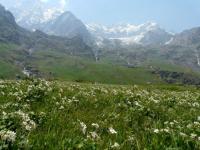 Climbing up from the bridge, the path is narrow and the river is way
down below, with rocky slopes on both sides. Soon we reach the glacier
which, of course, is not frozen in these months. After a 3 km uphill
walk, we enter the valley, which is marked by crossing a woodden bridge,
with map of valley put up next to it. There is a huge rock, with people
climbing over it. We feel thirsty and fill our bottle with the stream
water, which is cold and clear and tastes like mineral water (which it
is, literally) with a slight overdose of minerals. The vast expanse of
the valley is beautiful, and there are meadows of flowers as if
somebody is maintaining a huge flower farm. Big stretches of Himalayan
Balsam, which is the most predominant flower of the valley.
Climbing up from the bridge, the path is narrow and the river is way
down below, with rocky slopes on both sides. Soon we reach the glacier
which, of course, is not frozen in these months. After a 3 km uphill
walk, we enter the valley, which is marked by crossing a woodden bridge,
with map of valley put up next to it. There is a huge rock, with people
climbing over it. We feel thirsty and fill our bottle with the stream
water, which is cold and clear and tastes like mineral water (which it
is, literally) with a slight overdose of minerals. The vast expanse of
the valley is beautiful, and there are meadows of flowers as if
somebody is maintaining a huge flower farm. Big stretches of Himalayan
Balsam, which is the most predominant flower of the valley.
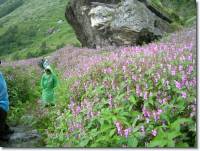 The sheer number of certain flowers is so large that most people tend to
think that there are only a few kinds of flowers there. Sometimes one
has to stop and gaze, to spot some new flowers. Sometimes one has to
wade in knee-deep flowers to reach an area which could have flowers of a
different kind. The more you look, the more you see, and there doesn't
seem to be a limit to it. Another flower which is present in large
number is the Himalayan Hogweed. The name is misleading, because the white
flat-topped flower clusters swaying in the breeze is a delightful sight.
Then there is another alluring plant, which is touted as the most
beautiful one in the valley, the Himalayan Whorlflower. It adds charm to
the Valley of Flowers, and grows in abundance. Bears tiered whorls of
fragrant white flowers that turn pale pink and then rosy red with time.
The sheer number of certain flowers is so large that most people tend to
think that there are only a few kinds of flowers there. Sometimes one
has to stop and gaze, to spot some new flowers. Sometimes one has to
wade in knee-deep flowers to reach an area which could have flowers of a
different kind. The more you look, the more you see, and there doesn't
seem to be a limit to it. Another flower which is present in large
number is the Himalayan Hogweed. The name is misleading, because the white
flat-topped flower clusters swaying in the breeze is a delightful sight.
Then there is another alluring plant, which is touted as the most
beautiful one in the valley, the Himalayan Whorlflower. It adds charm to
the Valley of Flowers, and grows in abundance. Bears tiered whorls of
fragrant white flowers that turn pale pink and then rosy red with time.
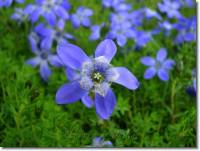 Further on, we are greeted with a captivating sight - low on the ground,
masses of wooly white flowers, which we recognize as the famous
Edelweiss. Edelweiss is the symbol of the Alps. It usually grows in
inaccessible places, at high altitudes in the mountains of Europe, Asia,
and South America. That is why it is associated in Slovenia with
mountaineering. Its white colour is considered in Switzerland a symbol
of purity and beauty.
Further on, we are greeted with a captivating sight - low on the ground,
masses of wooly white flowers, which we recognize as the famous
Edelweiss. Edelweiss is the symbol of the Alps. It usually grows in
inaccessible places, at high altitudes in the mountains of Europe, Asia,
and South America. That is why it is associated in Slovenia with
mountaineering. Its white colour is considered in Switzerland a symbol
of purity and beauty.
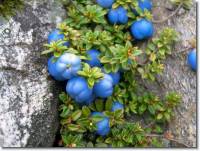 Some flowers grow on low ground, and one has to make an effort to spot them -
Trailing Bellflower is an example. In the world of flowers, blue is an unusual
color. But here, mother nature has splashed various shades of blue with
gay abundance. There are tiny beautiful blue flowers called
forget-me-not, spread throughout. The blue poppy is of course much
sought after. Infact, some tourists come all the way from Japan just to
have a look at this charming Himalayan flower. Then there are unusual
blue geraniums - we had seen numerous varieties of geraniums before
coming to the Valley, but all of them were pink or purple.
Some flowers grow on low ground, and one has to make an effort to spot them -
Trailing Bellflower is an example. In the world of flowers, blue is an unusual
color. But here, mother nature has splashed various shades of blue with
gay abundance. There are tiny beautiful blue flowers called
forget-me-not, spread throughout. The blue poppy is of course much
sought after. Infact, some tourists come all the way from Japan just to
have a look at this charming Himalayan flower. Then there are unusual
blue geraniums - we had seen numerous varieties of geraniums before
coming to the Valley, but all of them were pink or purple.
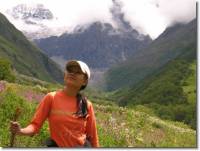 There are regions where tall plants are totally missing, but what is
there is even more enchanting. Uneven ground covered with grass and
rocks - small red berries spread over rocks in one place, small white flowers
dot the whole expanse; small asters, with blue daisy-like flowers heads
are seen every so often. We are enchanted with bunches of blue-berries,
and what a heavenly blue! We feel like Alice in wonderland. The place
doesn't let us move on - we just feel like exploring it more and
more.
There are regions where tall plants are totally missing, but what is
there is even more enchanting. Uneven ground covered with grass and
rocks - small red berries spread over rocks in one place, small white flowers
dot the whole expanse; small asters, with blue daisy-like flowers heads
are seen every so often. We are enchanted with bunches of blue-berries,
and what a heavenly blue! We feel like Alice in wonderland. The place
doesn't let us move on - we just feel like exploring it more and
more.
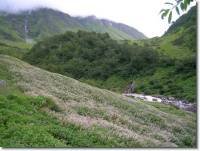 It doesn't take long in the Valley to start raining. Clouds decend
without warning, and it starts drizzling. We pull our Rs 15 raincoats
over our heads and carry on with with our enchanting journey.
In playful mood now, our excitement has ebbed. After a while, we lay
down in the grass, chat and admire the green expanse of the Valley, the
huge mountains on either side, and the snow peaks at the end of the Valley.
The sun is going down, and we have to start our journey back to Ghangria
before it gets dark.
It doesn't take long in the Valley to start raining. Clouds decend
without warning, and it starts drizzling. We pull our Rs 15 raincoats
over our heads and carry on with with our enchanting journey.
In playful mood now, our excitement has ebbed. After a while, we lay
down in the grass, chat and admire the green expanse of the Valley, the
huge mountains on either side, and the snow peaks at the end of the Valley.
The sun is going down, and we have to start our journey back to Ghangria
before it gets dark.
If one is serious about flowers, one day in the Valley is really
insufficient. So, we decided to spend another day, and explore areas
which we did not explore before. Next day we move faster through the parts
where we spent lot of time the previous day, and go further down the Valley.
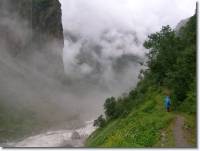 We see a
signboard indicating the way to the grave of Mary Legge - we decide to
go there and pay our respects to an enthusiastic botanist and explorer
who lost her life in the Valley. In 1939, Miss Margarate Legge, a
botanist deputed by the botanical gardens of Edinburgh arrived at the
valley for further studies. While she was traversing some rocky slopes
to collect flowers, she had a fatal slip.
Her sister later visited the valley and erected a memorial
on the spot where she was buried by the locals. The following words are
inscribed on the stone:
We see a
signboard indicating the way to the grave of Mary Legge - we decide to
go there and pay our respects to an enthusiastic botanist and explorer
who lost her life in the Valley. In 1939, Miss Margarate Legge, a
botanist deputed by the botanical gardens of Edinburgh arrived at the
valley for further studies. While she was traversing some rocky slopes
to collect flowers, she had a fatal slip.
Her sister later visited the valley and erected a memorial
on the spot where she was buried by the locals. The following words are
inscribed on the stone:
"I will lift mine eyes unto the Hills
from whence cometh my help."
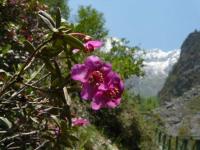 We walk further down the Valley and come to a stream which has a small bridge.
We spot a pink Geranium, which looks different from others. Geraniums are
a confusing lot, and some species vary so much in color, and resemble other
species that sometimes even experts get foxed. Walking ahead we see a charming
sight, tiny purple flowers hugging rocks. We recognize it as Himalayan Thyme.
In the Valley you will see lots
of flowers which prefer to stick to rocks, to growing in soil, and one
wonders why such strange behaviour. It turns out that it is a clever
survival strategy. Some soil gets collected in rock cervices and the seeds
of these tiny plants germinate very well in it. In normal soil, these tiny
plants would get swamped out by bigger, and more aggressive plants. The little
soil in rock cervices is of no use to the big bullies.
We walk further down the Valley and come to a stream which has a small bridge.
We spot a pink Geranium, which looks different from others. Geraniums are
a confusing lot, and some species vary so much in color, and resemble other
species that sometimes even experts get foxed. Walking ahead we see a charming
sight, tiny purple flowers hugging rocks. We recognize it as Himalayan Thyme.
In the Valley you will see lots
of flowers which prefer to stick to rocks, to growing in soil, and one
wonders why such strange behaviour. It turns out that it is a clever
survival strategy. Some soil gets collected in rock cervices and the seeds
of these tiny plants germinate very well in it. In normal soil, these tiny
plants would get swamped out by bigger, and more aggressive plants. The little
soil in rock cervices is of no use to the big bullies.
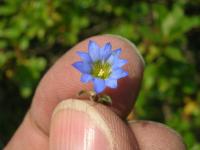 Leaving the pebbled track, we move into the grass in search of more
flowers, and nearly stamp over really tiny blue flowers. These are very
tiny, but very beautiful. In the Valley one will truely understand the
meaning of "small is beautiful". There are some flowers so tiny that,
although one get attracted to them by their vivid colors, it is hard to get
your camera to focus on them. We reach the last of the major streams,
called Dona gair stream. If one has reached this point, it means
one has explored
the best part of the Valley. This area has a completely different
character. Epilobium latifolia, which is aptly called River Beauty,
is seen growing along the banks of the stream. A new pink species of Geranium
appears here, which is not seen in most parts of the Valley. There is
Himalayan Thyme all over on the rocks, many times growing together with some
yellow flowers which we are unable to identify. We come across a lone, small
Bhojpatra tree, with paper-white bark. The bark of Bhojpatra was used in
ancient times for
writing. We decide not to go ahead beyond this point, and start our jounrney
back to Ghangria.
Leaving the pebbled track, we move into the grass in search of more
flowers, and nearly stamp over really tiny blue flowers. These are very
tiny, but very beautiful. In the Valley one will truely understand the
meaning of "small is beautiful". There are some flowers so tiny that,
although one get attracted to them by their vivid colors, it is hard to get
your camera to focus on them. We reach the last of the major streams,
called Dona gair stream. If one has reached this point, it means
one has explored
the best part of the Valley. This area has a completely different
character. Epilobium latifolia, which is aptly called River Beauty,
is seen growing along the banks of the stream. A new pink species of Geranium
appears here, which is not seen in most parts of the Valley. There is
Himalayan Thyme all over on the rocks, many times growing together with some
yellow flowers which we are unable to identify. We come across a lone, small
Bhojpatra tree, with paper-white bark. The bark of Bhojpatra was used in
ancient times for
writing. We decide not to go ahead beyond this point, and start our jounrney
back to Ghangria.
Hemkund
When we started out from Ghangria, if we had taken the right side path,
it would lead us to a difficult and steep climb which goes on for 5 km.
And it takes one to an altitude of 4,329 metres! Hemkund is a beautiful
lake at this altitude, surrounded by snow peaks. There is a gurdwara,
Hemkund Sahib, and a Lakshman temple on the banks of this lake.
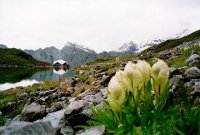 At an altitude of 4,329 metres, these are the highest places of worship in
India. Hemkund literally means 'lake of ice' - and true to its name, for
eight months of the year this lake is frozen and inaccessible.
When the weather warms up, the ice and snow
melt, and meadows of ferns and moss and wildflowers sprout on its banks.
Then, in their thousands, Sikhs climb the steep stone path to the lake
and bathe in its chilled waters. They come in the belief that
Guru Govind Singh meditated here in a previous birth. For the
non-religious, the place holds its charm with its aquamarine lake
surrounded by beautiful peaks. And this is the right altitude for many
rare flowers. The famed Brahmakamal grows in abundance amidst the rocks
on the banks of the lake.
At an altitude of 4,329 metres, these are the highest places of worship in
India. Hemkund literally means 'lake of ice' - and true to its name, for
eight months of the year this lake is frozen and inaccessible.
When the weather warms up, the ice and snow
melt, and meadows of ferns and moss and wildflowers sprout on its banks.
Then, in their thousands, Sikhs climb the steep stone path to the lake
and bathe in its chilled waters. They come in the belief that
Guru Govind Singh meditated here in a previous birth. For the
non-religious, the place holds its charm with its aquamarine lake
surrounded by beautiful peaks. And this is the right altitude for many
rare flowers. The famed Brahmakamal grows in abundance amidst the rocks
on the banks of the lake.
Leaving nature's paradise
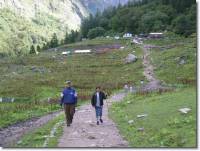 After exploring the Valley, we are back to our hotel room in Ghangria.
We have to leave the next day. Ghangria generally has no electricity
throughout the day. Power comes only in the evenings, around 6-7 PM.
Because of rain and little sun, our wet clothes and shoes do not get dry
even in two days. We have run out of fresh clothes. We are in need of going
to a dry area and have nice bath and wear fresh clothes. But we are sad
to leave this heavenly place. Next day in the morning, we start our
downhill trek, back to Govindghat. The climb down is much easier, and we
see new visitors huffing and puffing while coming up, and remember our
difficult uphill trek. Our porter wants to stop for lunch at a dhaba on
the way. We know that the place he eats will serve simple homely
food. So, we eat in the same place, a tasty meal of dal, rice and
vegetable. A pleasant change from the dal-makhani which we had been eating
at Ghangria.
After exploring the Valley, we are back to our hotel room in Ghangria.
We have to leave the next day. Ghangria generally has no electricity
throughout the day. Power comes only in the evenings, around 6-7 PM.
Because of rain and little sun, our wet clothes and shoes do not get dry
even in two days. We have run out of fresh clothes. We are in need of going
to a dry area and have nice bath and wear fresh clothes. But we are sad
to leave this heavenly place. Next day in the morning, we start our
downhill trek, back to Govindghat. The climb down is much easier, and we
see new visitors huffing and puffing while coming up, and remember our
difficult uphill trek. Our porter wants to stop for lunch at a dhaba on
the way. We know that the place he eats will serve simple homely
food. So, we eat in the same place, a tasty meal of dal, rice and
vegetable. A pleasant change from the dal-makhani which we had been eating
at Ghangria.
After a few hours of trekking and flower-spotting, we are back at Govindghat. We look for the first shared Sumo, and reach Joshimath and check into the same hotel that we had left. A bath and fresh, dry clothes do wonders and we doze off. We get up and relax, talking about the trip and looking at pictures in our digital camera. We seem to have got over 80 new flowers.
Next morning, the trip back to Rishikesh is long but uneventful, except for a few places where landslide had occured. By late evening, we reach Rishikesh and check into a hotel. Next morning, we catch a bus to Delhi. The life of plains now appears very dusty, crowded and pointless. We wonder if people grinding through their daily lives are aware that their exists a charming place called the Valley of Flowers.
|
|
|
| Rs. | |
| Delhi-Rishikesh by bus: | 200 |
| Delhi-Dehradoon by AC bus: | 450 |
| Delhi-Haridwar by Jan Shatabdi: | 500 |
| Rishikesh-Joshimath by shared Sumo: (basically Rs 1.15 per km) | 300 |
| Rishikesh: 2-bed hotel room | 600-900 |
| Joshimath: 2-bed hotel room | 630 (GMVN guesthouse) |
| Ghangria: 2-bed hotel room (varies on the demand) | 700-1200 |
| Joshimath/Ghangria: 3 people having a meal | 250 |
| Porter from Govindghat to Ghangria | 450 |
| Horse from Govindghat to Ghangria | 450 |
| At Ghangria, all packaged items are double the marked price: A Rs 20 Pepsi costs Rs 40. |
| Place | Altitude (meters) | Distance | |
| 1 | Joshimath | 1,890 | 252 km, 8-9 hours drive from Rishikesh |
| 2 | Govindghat | 1,828 | 21 km, 1 hour drive from Joshimath |
| 3 | Ghangria | 3,048 | 14 Km, trek from Govindghat. |
| 4 | Valley Of Flower | 3,352 - 3,658 | 3 km from Ghangria |
| 5 | Hemkund | 4,329 | 5 km steep climb from Ghangria. |
Suggested trip plan:
Day 01: Delhi-Rishikesh (230 Kms)
Take a bus from ISBT, Delhi in the morning. The bus takes about 6 hours.
No AC buses to Rishikesh. You can take an AC bus to Dehradun, and take a
shared Sumo from there to Rishikesh (45 mins).
Alternatively, take one of the many trains to Haridwar, and then take a
bus to Rishikesh. Haridwar and Rishikesh are close by.
Overnight stay at Rishikesh.
Day 02: Rishikesh-Joshimath (250 Kms)
After breakfast leave for Joshimath. The earlier you leave, the better
it is. Lunch enroute in Rudraprayag.
Overnight stay at Joshimath.
Joshimath is the winter home of Sri Badrinathji. It is situated on the
slopes above the confluence of Alaknanda and Dhauliganga. It is one of the
'maths' established by Adi guru Shankaracharya.
|
1. Hotel M.J. Comfort (9897144495, 9758610841): Bang next to the bus stand. brand new, excellent rooms. Double-room 1000 (AC), 700 (Non-AC). They don't serve food, only tea. Excellent value for money. 2. Akash Ganga (2430870, 2430451, 5540513): Walking distance from bus stand, Rs. 700-900 double-room. Old big rooms, not very good but okay for one night. Joshimath 1. GMVN guesthouse: In the upper bazar. Rs 630 for basic, clean, double-rooms. Serve good food. Good value for money. 2. Many other places very close-by. Cheaper ones also available. Ghangria 1. GMVN guesthouse: Double-rooms - Rs 1200 deluxe, Rs. 1150 hut, Rs 850 economy rooms, Rs 180 per bed dormitory. Best place to stay. Will be fully booked in the peak season. Book online 2. Lots of other places with varying prices. |
Day 04: Ghangria - Valley of flowers -
Ghangria (7+ km trek)
After breakfast, leave for Valley of flowers with packed lunch. Return back to
Ghangria. Overnight stay at Ghangria
High in the Himalayan ranges of Garhwal hills of Uttaranchal lies an
enchanted valley. Here flowerful pastures with clear
running streams are set against silver birches and shining snow peaks
- a must see for all nature lovers.
Day 05 : Ghangria-Hemkund (5 Kms steep
climb)
After breakfast, leave for Hemkund with packed lunch. Return
back to Ghangria. Overnight stay at Ghangria
Hemkund is a beautiful lake at a breathtaking altitude of 4,300 m, and
has a gurdwara, Hemkund Sahib, which a holy place for the sikhs.
Day 06 : Ghangria-Govindghat-Joshimath (14 km downhill trek +
1 hr drive)
Start after breakfast and trek to Govindghat. Lunch on the way. From
Govindghat, take a shared Sumo to Joshimath. Overnight stay at
Joshimath.
Day 07: Joshimath - Rishikesh (250 kms)
Early morning leave for Rishikesh by shared Sumo. Overnight stay at
Rishikesh.
Day 08: Rishikesh - Delhi (230 kms)
Early morning leave for Delhi by bus.